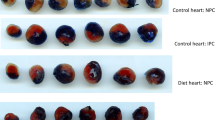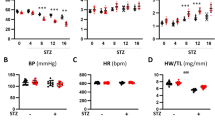Abstract
Previous studies have shown that propionyl-L-carnitine (PLC) can exert cardiac antiischemic effects in models of diabetes. In the nonischemic diabetic rat heart, PLC improves ventricular function secondary to stimulation in the oxidation of glucose and palmitate. Whether this increase in the oxidation of these substrates can explain the beneficial effects of PLC in the ischemic reperfused diabetic rat heart has yet to be determined. Diabetes was induced in male Sprague-Dawley rats by an intravenous injection of streptozotocin (60 mg/kg). Treatment was initiated by supplementing the drinking water with propionyl-L-carnitine at the concentration of 1 g/L. After a 6-week treatment period, exogenous substrate oxidation and recovery of mechanical function following ischemia were determined in isolated working hearts. In aerobically perfused diabetic hearts, compared with those of controls, rates of glucose oxidation were lower, but those of palmitate oxidation were similar. Diabetes was also characterized by a pronounced decrease in heart function. Following treatment with by propionyl-L-carnitine, however, there was a marked increase in rates at which glucose and palmitate were oxidized by diabetic hearts and a significant improvement in heart performance. Postischemic recovery of function in diabetic hearts was also improved with PLC. This improvement in contractile function was accompanied by an increase in both glucose and palmitate oxidation. Our findings show that postischemic diabetic rat heart can be improved following chronic PLC treatment. This beneficial effect of propionyl-L-carnitine can be explained, in part, by an improvement in the oxidation of glucose and palmitate.
Similar content being viewed by others
References
Fein FS: Diabetic cardiomyopathy. Diabetes Care 13:(suppl 4) 1169-1179, 1990
Kannel WB, Hjortland M, Castelli WP: The role of diabetes in congestive heart failure: The Framingham study. Am J Cardiol 34: 29-34, 1974
Kannel WB, McGee DL: Diabetes and cardiovascular risk factors: The Framingham study. Circulation 59: 8-13, 1976
Regan TJ: Congestive heart failure in the diabetic. Ann Rev Med 34: 161-168, 1983
Lopaschuk GD: Abnormal mechanical function in diabetes: Relationship to altered myocardial carbohydrate/lipid metabolism. Cor Art Dis 7: 116-123, 1996
Oliver MF, Opie LH: Effects of glucose and fatty acids on myocardial ischemia and arrhythmias. Lancet 343: 155-158, 1994
Rodrigues B, Cam MC, McNeill JH: Myocardial substrate metabolism: Implications for diabetic cardiomyopathy. J Mol Cell Cardiol 27: 169-179, 1995
Garvey WT, Hardin D, Juhaszova M, Dominguez JH: Effects of diabetes on myocardial glucose transporter systems in rats: Implications for diabetic cardiomyopathy. Am J Physiol 264: H837-H844, 1993
Avogaro A, Nosadini R, Doria A, Fioretto P, Velussi M, Vigorito C, Sacca L, Toffolo G, Cobelli C, Trevisan R: Myocardial metabolism in insulin-deficient diabetic humans without coronary artery disease. Am J Physiol 258: H606-H618, 1990
Pierce GN, Dhalla NS: Heart mitochondrial function in chronic experimental diabetes in rats. Can J Cardiol 1: 48-54, 1984
Wall SR, Lopaschuk GD: Glucose oxidation rates in fatty acidperfused isolated working hearts from diabetic rats. Biochem Biophys Acta 1006: 97-1003, 1989
Neely JR, Morgan HE: Relationship between carbohydrate and lipid metabolism and the energy balance of the heart. Ann Rev Physiol 36: 413-459, 1974
Kerbey AL, Vary TC, Randle PJ: Molecular mechanisms regulating glucose oxidation. Basic Res Cardiol 80:(suppl 2) 93-96, 1995
Paulson DJ, Crass MF: Endogenous triacylglycerol metabolism in diabetic heart. Am J Physiol 242: H1084-H1094, 1982
Chatham JC, Forder JR: Relationship between cardiac function and substrate oxidation in hearts of diabetic rats. Am J Physiol 273: H52-H58, 1997
Bunger R, Mallet RT, Hartman DA: Pyruvate-enhanced phosphorylation potential and inotropism in normoxic and postischemic isolated working heart. Eur J Biochem 180: 231-233, 1989
Liedtke AJ, DeMaison L, Nellis S: Effects of L-propionylcarnitine on mechanical recovery during reflow in intact hearts. Am J Physiol 255: H169-H176, 1988
Lopaschuk GD: Alterations in fatty acid oxidation during reperfusion of the heart after myocardial ischemia. Am J Cardiol 80: 11A-16A, 1997
Broderick, TL, Quinney HA, Lopaschuk GD: L-carnitine increases glucose metabolism and mechanical function following ischemia in diabetic rat heart. Cardiovasc Res 29: 373-378, 1995
McVeigh JJ, Lopaschuk GD: Dichloroacetate stimulation of glucose oxidation improves recovery of ischemic rat hearts. Am J Physiol 259: H1070-H1085, 1990
Nichol TA, Lopaschuk GD, McNeill JH. The effects of free fatty acids and dichloroacetate on the isolated working diabetic rat heart. Am J Physiol 261: H1053-H1059, 1991
Arsenian MA: Carnitine and its derivatives in cardiovascular disease. Prog Cardiovasc Dis 40: 265-286, 1997
Bartels GL, Remme WJ, Pillay M, Schonfeld DHW, Cox PH, Kruijssen M, Knuf NMJ: Acute improvement of cardiac function with intravenous L-propionylcarnitine in humans. J Cardiovasc Pharmacol 20: 157-164, 1992
El Alaoui-Talibi Z, Guendouz A, Moravec M, Moravec J: Control of oxidative metabolism in volume-overloaded rat hearts: Effect of propionyl-L-carnitine. Am J Physiol 272: H1615-H1624, 1997
Ferrari R, DeGuili F: The propionyl-L-carnitine hypothesis: An alternative approach to treating heart failure. J Card Fail 3: 217-224, 1997
Paulson DJ, Shug AL, Zhao J: Protection of the ischemic diabetic heart by L-propionylcarnitine therapy. Mol Cell Biochem 116: 131-137, 1992
Schonekess B, Allard MF, Lopaschuk GD: Propionyl L-carnitine improvement of hypertrophied heart function is accompanied by an increase in carbohydrate oxidation. Circ Res 77: 726-734, 1995
Broderick TL, Haloftis G, Paulson DJ: L-propionylcarnitine enhancement of substrate oxidation and mitochondrial respiration in the diabetic rat heart. J Mol Cell Cardiol 28: 331-340, 1996
Saddik M, Lopaschuk GD: Triacylglycerol turnover in isolated working hearts of acutely diabetic rats. Can J Physiol Pharmacol 72: 1110-1119, 1994
Terada R, Matsubara T, Koh N, Nakamura J, Hotta N: Effects of propionyl-L-carnitine on cardiac dysfunction in streptozotocindiabetic rats. Eur J Pharmacol 357: 185-191, 1998
Packer L, Valenza M, Serbinova E, Starke-Reed P, Frost K, Kagan V: Free radical scavenging is involved in the protective effect of L-propionyl-carnitine against ischemia-reperfusion injury of the heart. Arch Biochem Biophys 288: 522-527, 1991
Pengfei WU, Sato J, Zhao Y, Jaskiewics J, Popov KM, Harris RA: Starvation and diabetes increase the amount of pyruvate dehydrogenase kinase isoenzyme 4 in rat heart. Biochem J 329: 197-202, 1998
Feuvray D, Lopaschuk GD: Controversies on the sensitivity of the diabetic heart to ischemic injury: The sensitivity of the diabetic heart to ischemic injury is decreased. Cardiovasc Res 34: 113-120, 1997
Paulson DJ: The diabetic heart is more sensitive to ischemic injury. Cardiovasc Res 34: 104-112, 1997
Broderick TL, Barr RL, Quinney AH, Lopaschuk GD: Acute insulin withdrawal from diabetic BB rats decreases myocardial glycolysis during low-flow ischemia. Metabolite 41: 332-338, 1992
Hekimian G, Feuvray D: Reduction of ischemia-induced acylcarnitine accumulation by TGDA and its influence on lactate dehydrogenase release in diabetic rat hearts. Diabetes 35: 906-910, 1986
Paulson DJ, Kopp J, Peace DJ, Tow JP: Improved postischemic recovery of cardiac pump function in exercised trained diabetic rats. J Appl Physiol 65: 187-193, 1988
Khandoudi N, Bernard M, Cozzone P, Feuvray D: Intracellular pH and the role of Na+/H+ exchange during ischemia and reperfusion of normal and diabetic rat hearts. Cardiovasc Res 24: 873-878, 1990
Tani M, Neely JR: Hearts from diabetic rats are more resistant to in vitro ischemia: Possible role of altered Ca2+ metabolism. Circ Res 62: 931-940, 1988
Broderick TL, Quinney HA, Barker CC, Lopaschuk GD: Beneficial effect of carnitine on mechanical recovery of rat hearts reperfused after a transient period of global ischemia is accompanied by a stimulation of glucose oxidation. Circulation 87: 972-981, 1993
McCormack JG, Barr RL, Wolff AA, Lopaschuk GD: Ranozaline stimulates glucose oxidation in the normoxic, ischemic and reperfused ischemic hearts. Circulation 93: 135-142, 1996
Gamble J, Lopaschuk GD: Glycolysis and glucose oxidation during reperfusion of ischemic hearts from diabetic rats. Biochem Biophys Acta 1225: 191-199, 1994
Tassani V, Cattapan F, Magnanimi L, Peschechera A: Anaplerotic effect of propionyl carnitine in rat heart mitochondria. Biochem Biophys Res Commun 198: 949-952, 1994
Russell RR, Mommessin JI, Taegtmeyer H: Propionyl-L-carnitinemediated improvements in contractile function of rat hearts oxidizing acetoacetate. Am J Physiol 268: H441-H447, 1995
De Lisa F, Menabo R, Siliprandi N: L-propionyl-carnitine protection of mitochondria in ischemic rat hearts. Mol Cell Biochem 88: 169-173, 1989
Lysiak W, Lilly K, DiLisa F, Toth PP, Bieber LL: Quantification of the effect of L-carnitine on the levels of acid-soluble shortchain acyl CoA in rat heart and liver mitochondria. J Biol Chem 263: 1511-1516, 1988
Broderick TL, Quinney HA, Lopaschuk GD: Carnitine stimulation of glucose oxidation in the fatty acid perfused isolated working rat heart. J Biol Chem 267: 3758-3763, 1992
Rodrigues B, Xiang H, McNeill JH: Effect of L-carnitine treatment on lipid metabolism and cardiac performance in chronically diabetic rats. Diabetes 37: 1358-1364, 1988
Author information
Authors and Affiliations
Rights and permissions
About this article
Cite this article
Broderick, T.L., Driedzic, W. & Paulson, D.J. Propionyl-L-carnitine effects on postischemic recovery of heart function and substrate oxidation in the diabetic rat. Mol Cell Biochem 206, 151–157 (2000). https://doi.org/10.1023/A:1007022114594
Issue Date:
DOI: https://doi.org/10.1023/A:1007022114594




